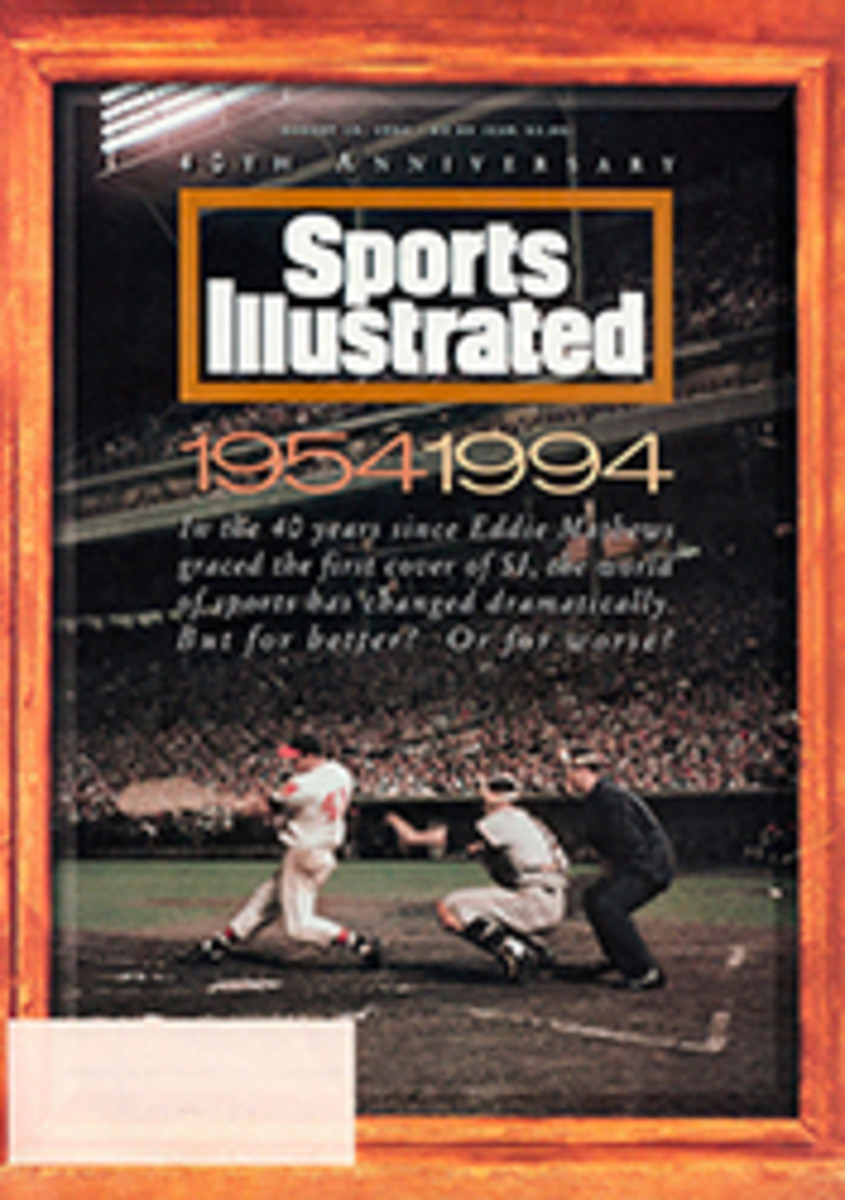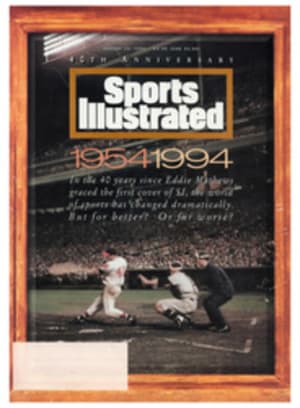
Taking Stock
So here's the deal. By the time Jeff Gordon is old enough to tell his grandbabies about last Saturday's inaugural Brickyard 400, the Indianapolis Motor Speedway will no doubt be running snowmobile races, dog races and wheelbarrow races. For now, though, Gordon's victory in the first NASCAR race at the 84-year-old track must be considered historic. Given that, as the stock car boys would say, it was a pretty neat deal.
The 23-year-old Gordon had the strongest car all day, but with only five laps left in the 160-lap race he found himself hanging on to the back bumper of Ernie Irvan, who had steadily worked himself up from the 17th starting position and had been swapping the top spot with Gordon for 15 laps. Irvan had so disrupted the grip of Gordon's car by falling in directly behind him that Gordon was finally forced to let him go by. "It was a mind game," Irvan said later. "When Jeff was in front of me, I could get him loose, so I just kept messing with him."
With four laps to go, the two roared through the first turn side by side, Gordon's neon-colored car rising like a rainbow from the right fender of Irvan's thundering black cloud. "The last guy I wanted to race at the end was Ernie," said Gordon, who is in only his second full season of Winston Cup racing. As they emerged from Turn 2, Irvan's car seemed to shudder slightly and then drop back as his right front tire exploded. The rainbow sailed off on a rising are all the way to the finish line.
The race had a little something for everyone, not least of all a nasty blood feud between brothers Geoff and Brett Bodine, who were rumored to have clashed after a joint souvenir deal went sour, as well as after their mother suffered a heart attack last year. The Bodines were fighting for the lead on the 99th lap when they took turns nudging each other from behind, until Brett finally drove his older brother into the wall. "He spun me out," said Geoff, who after the crash sat close to tears in his garage while his crew tried in vain to repair his car. "We've been having some family problems, and he took it out on me on the track. I never expected he'd do it."
Brett, who wound up finishing second after Irvan's calamity, denied it all. "If there is bad blood, that's personal," he said. "I would not talk about it in public. I don't let family problems run onto the racetrack. He's always looking to blame people for something like that. It goes back to when we were kids in his mind. It's not that way in my mind." This week, before the NASCAR race at Watkins Glen, N.Y., the Bodines have planned "a big family-reunion-type deal," says Brett, at which the covered dishes will no doubt be eyed more warily than usual.
The clannish nature of racing has produced many bitter rivalries, but none of longer standing than the undeclared war between the distant principalities of Indianapolis and Daytona. Somewhere around the dawn of recorded time, the Speedway became such a sacred racing shrine that circuits other than Indy Car had about as much chance of gaining entry as a mutt does to the Westminster Dog Show. The Indianapolis 500, the only race until last week that had ever been held at the Speedway, draws the biggest crowd of any single-day sporting event in the world, which is why the people who run stock car racing had been having about 12 different kinds of hemorrhages trying to get a race date there.
The deal was finally worked out a year ago between Bill France Jr., whose daddy pretty much invented NASCAR before turning it over to his son, and Tony George, grandson of longtime Speedway owner Tony Hulman, who was given control of the Speedway by his mother four years ago. The Brickyard 400 represented a kind of state marriage between those feudal racing lords, with much talk of making history and considerable thought given to making a buck.
"This is a big deal," said veteran driver Darrell Waltrip. "Of all the deals I've been involved in, this is a big deal. We won't know how big a deal it was until we've gone down the road a ways, but this deal is big."
Just how big is difficult to say because the Speedway refuses to reveal even its seating capacity, much less its profits. (Annoyed by the track's secrecy, actor and Indy Car owner Paul Newman paid some local college students last year to go out and sit in every seat, and they came up with a bottom-callusing count of 287,000.) After France and George announced the deal, the Speedway received a million ticket requests in a single day, including 5,000 pieces of overnight mail. The race clearly fed a hunger that had been building for some time.
NASCAR made a futile effort to contain the monster it had helped create by demanding that the Brickyard purse not exceed that of the Daytona 500. But in the end the total purse was $3.21 million (a half-million more than the '94 Daytona), the largest in NASCAR history.
"At all the banquets I go to, the one question I get about 90 times out of 100 is, 'Have you ever raced at Indy?' " said Waltrip, a three-time Winston Cup champion. "Right away you have to start making excuses. Now they can ask those Indy Car guys if they've ever raced at Daytona."
In addition to whatever Beverly Hillbillies-style prestige was conferred upon the visiting stock car racers, who seemed to be in on the joke that they were seen as a bunch of yahoos with their shirttails hanging out, was the undeniable thrill of having finally arrived at the center of the racing universe.
With all the talk of the historical significance of the race, and the constant drum-beat about the Brickyard's hallowed ground, you would have thought the NASCAR boys had driven into Arlington Cemetery doing doughnuts. But most of that was forgotten when qualifying began last Thursday afternoon. The stock cars looked about half as fast going around the track as Indy Cars, and they sounded about twice as loud. The man chosen by lot to make the first qualifying lap was H.B. (Herring Burl) Bailey, 57, short and stout, whose bearded face is as wide and flat as a shovel. Bailey said he initially was disappointed when he found himself in the leadoff spot, "but then when I found out how privileged we were to be first, I reconsidered the thing."
Bailey's speed was quickly posted at 172 mph, and it produced the first sustained roar from the opening-day crowd. But the speed was just as quickly revised down to 152 mph, which would eventually prove to be the slowest of the 68 qualifying attempts that day. "Usually you'd bolt on a new set of tires and make a banzai run," said Bailey of his historic moment, "but I didn't use new tires because, basically, I decided to save myself $1,200 on a set of tires."
The most notable difference between the regular fans at Indianapolis and stock car fans became obvious at 9:30 Thursday morning, when the cavalry charge of race cars rolled onto the track for the first practice session. The NASCAR fans hustled to their seats and planted their double-wides in them for as long as the perfume of gasoline wafted through the air.
For the Indy 500 the month of May is devoted more to leisure-time activities, such as asking when Emmo's coming out, comparing the sunburns of shirtless fat guys, asking when Nigel's coming out, and, of course, throwing up in the infield. Just to be on the safe side the Speedway chose not to set up about 35,000 temporary bleacher seats, normally in place for the 500, probably so nobody would get the idea of wintering there. That left it to the racers and the two occupying media armies (Yankees and Rebs) who had come to record the historic armistice at this automotive Appomattox.
Pretty much everybody was entered in the thing. Some people you had never heard of, a lot you wish you hadn't, and the combined Wonderland-Graceland entry of the No. 54 car, owned by Leo E. Jackson Jr. and driven by Robert Pressley. It seemed like a marriage made in stock car heaven, but the car finished 50th in qualifying on Thursday, and by Friday night Pressley had left the building. So had 66-year-old driver Hershel McGriff, who also had competed in NASCAR's first super-speedway race at Darlington, S.C., in 1950. McGriff didn't make the field, but his 401 (k) plan matured during qualifying.
Among the Indy Car regulars who showed up, only Australia's Geoff Brabham made the race, which figured, because he was from farther south than anybody else. A.J. Foyt, 59, unretired long enough to qualify dead last. The track announcer said he was sure A.J.'s wife wasn't happy that her husband was racing. "Well, my girlfriend is, so who cares?" Foyt drawled. He might want to watch what he eats at his next covered-dish supper, too.
Gordon's domestic situation seemed calm by comparison. He grew up only a few miles from the Speedway, in Pittsboro, Ind., and had the sense to go around saying things like, "Indiana is my hometown." So his victory had the added virtue of electrifying the enormous crowd. No one was more thrilled than Brooke Sealey, a former Miss Winston to whom Gordon became engaged at this year's Daytona 500 in February. If their marriage can produce a union as happy as the one between NASCAR and Indianapolis did last week...well, they'll have the Bodines beat.
PHOTO
JOHN DAVIDSON/AP
Geoff (left, and driving No. 7) blasted Brett, whose brotherly shove knocked the elder Bodine out of the race.
PHOTO
GEORGE TIEDEMANN
[See caption above.]
PHOTO
JOHN BIEVER
[See caption above.]
PHOTO
BUCK MILLER
After he grabbed the lead from the shrewd but unlucky Irvan, Gordon was on top of the world.
PHOTO
GEORGE TIEDEMANN
[See caption above.]
PHOTO
TOM LYNN
PHOTO
GEORGE TIEDEMANN

